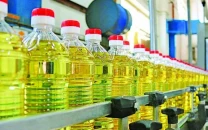9MCY14: Credit may be down but ‘Big 5’ still raking in
Net profit of all banks clocked up at Rs115.4 billion

Credit to the private sector has been depressed of late, but that does not mean banks are down and out in Pakistan. If anything, they’re racking in money like never before.
Net profits of all banks at the end of the third quarter of 2014 – the latest nine months for which data is available – clocked up at Rs115.4 billion. To put this figure in perspective, consider the fact that their net profits in the first three quarters of 2014 have already surpassed their total earnings of Rs112.4 billion recorded in the last calendar year.

While banks’ pre-tax earnings in January-September have gone up 44% from the same period of 2013, the share of loans and advances in their total mark-up earned has actually decreased from 50% to 47.8% over the same period. With Rs326.6 billion, investments formed the largest part in banks’ mark-up earned in January-September.
Let’s take a look at the banks’ latest financials to assess how well they have done in the last nine months with respect to their close competitors.
Large banks
Of the so-called ‘Big 5’ commercial banks operating in Pakistan, Habib Bank (HBL) grossed the highest after-tax profit in the first nine months of 2014. Its net profit amounted to Rs20.5 billion, up 32.2% from its earnings recorded at the end of September 2013.
However, National Bank of Pakistan (NBP) recorded the largest increase in both absolute and percentage terms in the nine-month period ending on September 30. NBP’s net profit amounted to Rs12 billion until September, up a massive 107.1%, or Rs6.2 billion, from the corresponding period of the last year.

HBL also led the ‘Big 5’ on the deposits front, with its term, savings and current deposits reaching Rs1.3 trillion at the end of September, up 2% from December 2013.
However, the largest increase in deposits in percentage terms since December 2013 was by Allied Bank (ABL). Its deposits grew 5.75% in the nine-month period to Rs643.3 billion.
When it comes to extending credit, NBP is far ahead of the rest of the four big banks with its loans and advances amounting to a staggering Rs700.6 billion at the end of September. Its closest rival in the loans and advances category was HBL with a loan portfolio of Rs572.5 billion.
However, the largest increase in loans and advances in relative terms was recorded by MCB Bank in January-September. Its gross loans and advances grew by 14.8% in the last nine months to Rs308.1 billion at the end of September.
Mid-size banks
Standard Chartered has been the most profitable bank in 2014 so far with net earnings clocking up at Rs7.4 billion in the last nine months.
Bank AL Habib came at a distant second with net earnings of Rs4.4 billion in 2014 so far, up 20.5% from a year ago. With a wider branch network than Bank AL Habib, Bank Alfalah posted a net profit of a little over Rs4 billion.
However, the percentage increase in its earnings on a year-on-year basis was slightly greater than that of Bank AL Habib.

Bank AL Habib also outperformed Bank Alfalah in deposits growth.
Bank AL Habib’s deposits increased 13% since the start of 2014 to reach Rs436.3 billion at the end of September. Bank Alfalah carries the largest deposits among all mid-size banks. They increased 7.2% over the nine-month period to Rs563.6 billion.
The biggest increase in deposits among mid-size banks in percentage terms was recorded by Habib Metropolitan Bank. Its deposits grew 20.9% to Rs299.4 billion at the end of September.
Small banks
The most profitable entity among small banks in January-September was Bank of Khyber that posted net earnings of 826.1 million, up 2.4% from the same nine-month period of the last calendar year.

The second most profitable bank in this category was Sindh Bank with a net profit of Rs720.2 million, up 14.5% from a year ago.
Summit Bank, JS Bank and Khyber Bank had the largest amounts of deposits among small banks with Rs105.5 million, Rs101.9 million and Rs83.7 million, respectively, at the end of September.
In percentage terms, however, the largest increase over the nine-month period was recorded by Samba Bank (30.1%), Sindh Bank (27.6%) and JS Bank (25.9%).
Summit Bank led small banks in terms of its loan portfolio. Its loan and advances amounted to Rs72.6 billion at the end of September, up 10.8% from the beginning of the year. It was followed by Silk Bank that increased its loans and advanced by 5.9% to Rs65.1 billion.

In percentage terms, Sindh Bank expanded its footprint in loans and advances most rapidly. It equalled Rs37.5 billion, up a massive 41.5% from the end of 2013.
Islamic banks
Meezan Bank safely managed to retain its status as the single largest Islamic bank operating in the country, with a net profit of Rs3.5 billion at the end of September. Its profitability went up 24.3% from a year ago.
Excluding Dubai Islamic Bank, whose latest quarterly financials are not currently available, the second most profitable bank in Pakistan in January-September was Bank Islami with net earnings of Rs291.9 million.
Bank Islami outperformed Meezan Bank in terms of the percentage increase in deposits during the last nine months. Bank Islami’s deposits increased 19% to reach Rs89.5 billion at the end of September.
In contrast, the corresponding increase in deposits by Meezan Bank was 13.8%, resulting in the figure of Rs329.9 billion at the end of the first nine months of 2014.

Growth in gross loans and advances by Meezan Bank and Bank Islami was 8% and 12%, respectively, since the end of 2013. In contrast, AlBaraka Bank and Burj Bank posted negative growth of 2% and 1.2%, respectively, in their gross loans and advances in January-September.
THE WRITER IS A STAFF CORRESPONDENT
Published in The Express Tribune, November 24th, 2014.
Correction: Changes have been made to reflect the profits of small banks in millions. The earlier version mistakenly showed their profitability in billions.
Like Business on Facebook, follow @TribuneBiz on Twitter to stay informed and join in the conversation.a



















COMMENTS
Comments are moderated and generally will be posted if they are on-topic and not abusive.
For more information, please see our Comments FAQ